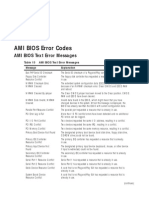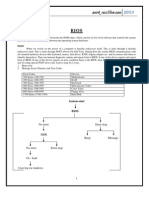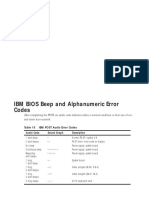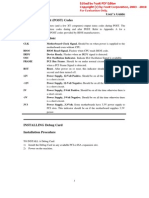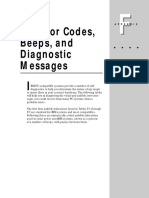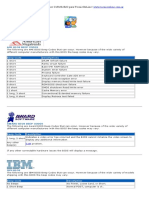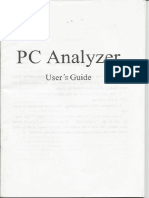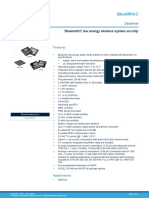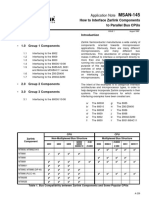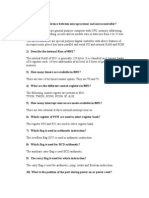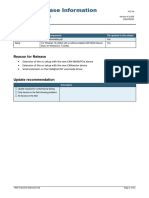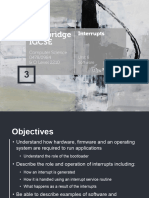Phoenix BIOS Text Error Messages
Phoenix BIOS Post Procedures
Phoenix XT 2.52 PnP BIOS Post Codes
Phoenix BIOS Plus or v1.0 BIOS Post Codes
Phoenix UMC chipset PCI BIOS Post Codes
Phoenix PCI BIOS Post Codes
Phoenix ISA/EISA/MCA v3.07 BIOS Post Codes
Phoenix 4.0 BIOS Post Codes
Phoenix 4.0 Release 6.0 BIOS Post Codes
Phoenix BIOS Text Error Messages:
Diskette drive A
error
Drive A: is present but fails the POST diskette tests. Check that the drive is defined with the
proper diskette type in Setup and that the disk is installed correctly
Extended RAM
Extended memory not working or not configured properly at offset: nnn
failed at offset: nnn
Failing Bits: nnnn
The hexadecimal number nnnn is a map of the bits at the RAM address that failed the memory
test. Each 1 in the map indicates a failed bit
Fixed Disk 0 Failure
Fixed disk is not working or not configured properly. Check to see if fixed disk is installed
properly. Run Setup to be sure the fixed disk type is correctly identified
Fixed Disk 1 Failure
Fixed disk is not working or not configured properly. Check to see if fixed disk is installed
properly. Run Setup to be sure the fixed disk type is correctly identified
Fixed Disk Controller Fixed disk is not working or not configured properly. Check to see if fixed disk is installed
Failure
properly. Run Setup to be sure the fixed disk type is correctly identified
Incorrect Drive A:
type - run Setup
Type of diskette for drive A: not correctly identified in Setup
Invalid NVRAM
media type
Problem with NVRAM (CMOS) access
Keyboard controller
The keyboard controller failed test. Try replacing the keyboard
error
Keyboard error
Keyboard not working
Keyboard error nn
BIOS discovered a stuck key and displays the scan code nn for the stuck key
Keyboard locked Unlock key switch
Unlock the system to proceed
Monitor type does
not match CMOS Run Setup
Monitor type not correctly identified in Setup
�Operating system
not found
Operating system cannot be located on either A: or C:. Enter Setup and see if fixed disk and
drive A: are properly identified
Parity Check 1
Parity error found in the system bus. BIOS attempts to locate the address and display it on
screen. If it cannot locate the address, it displays ???
Parity Check 2
Parity error found in the I/O bus. BIOS attempts to locate the address and display it on
screen. If it cannot locate the address, it displays ???
Press <F1> to
resume, <F2> to
Setup
Displayed after any recoverable error message. Press F1 to start the boot process or F2 to
enter Setup and change any settings
Real-time clock
error
Real-time clock fails BIOS test. Might require motherboard repair
Shadow RAM failed
Shadow RAM failed at offset nnnn of the 64KB block at which the error was detected
at offset: nnnn
System battery is
The CMOS clock battery indicator shows the battery is dead. Replace the battery and run
dead - Replace and
Setup to reconfigure the system
run Setup
System cache error
RAM cache failed the BIOS test. BIOS disabled the cache
- Cache disabled
System CMOS
System CMOS RAM has been corrupted or modified incorrectly. Perhaps by an application
checksum bad - run program that changes data stored in CMOS. Run Setup and reconfigure the system either by
Setup
getting the default values or making your own selections
System RAM failed
at offset: nnnn
System RAM failed at offset nnnn of the 64KB block at which the error was detected
System timer error
The timer test failed. Requires repair of system motherboard
Return to Top
Phoenix BIOS Post Procedures:
CPU
Check internal operations i.e. ALE/IRQ status, Request, LA and memory read/write
CMOS RAM
Test with walking bit pattern
ROM BIOS
Perform checksum on ROM BIOS where all bits are added and compared to a factory set total
PIT
Check to ensure interrupt requests are properly executed
DMA
Check DMA from CPU to memory without BIOS. Also check page registers
Base 64K
Check first 4K block
Serial and Parallel
Ports
I/O data areas for any devices found are assigned but are not tested
PIC
Check that proper interrupt request levels are addressed
Keyboard Controller
Check 8240 for proper operation, including scan code response and Gate A20 which allows
CPU operation in protected mode
CMOS
Check data within CMOS and compare to BIOS information. Failure of the extended area is
often due to wrong data setup. Constant failure after resetting CMOS is either battery CMOS
chip or RTC
Video Controller
Test and initialize controller and ROM on the video adapter
RTC
Check to ensure proper frequencies are on proper lines for the Video Color CPU and DMA
frequency. Check RTC and PIT or the system crystal if a failure occurs
CPU
Return from protected mode. CPU is put into protected mode and returns to the POST at the
point indicated by the CMOS ROM data area byte 0F. Failure here is normally due to the CPU,
keyboard controller, CMOS chip or an address line
PIC
Test counter 2
NMI
Check for non maskable interrupt request vector for active status. Failure is normally due to
the CMOS but could also be the BIOS IRQ or CPU chips
Keyboard
Check for NumLock and/or Caps and Shift keys
Mouse
Initialize through the keyboard controller. This is only done if a mouse is present and it is
initialized in this way
RAM Above 64K
Test in 64KB blocks with a walking bit pattern and parity enabled
Fixed and Floppy
Controllers
Test for proper response to BIOS calls
�Shadow RAM Areas Look in CMOS for settings on which adapter or system ROM's are to be shadowed
Option ROM
Look for ROM signatures of 55AA in extended memory then initialize the ROM and halt testing
while internal checks are carried out
External Cache
Check controller chip for external cache
CPU Internal Cache The CPU's internal cache is tested
Hardware Interrupts Initialize and test video, floppy, hard I/O adapters, serial and parallel ports
Cassette
Test internal or external cassette drives
Boot Code Errors
Errors occurring after this point are normally a corrupt boot record
Return to Top
Phoenix XT 2.52 PnP BIOS Post Codes:
01
Test 8253 timer
02
First 64K RAM failed
03
First 1K parity check failed
04
Initialize 8259 interrupt controller
05
Second 1K RAM test, BIOS data area, failed
Return to Top
Phoenix BIOS Plus or v1.0 BIOS Post Codes:
01
CPU register test in progress
02
CMOS read/write failure
03
ROM BIOS checksum failure
04
Programmable interval timer failure
05
DMA initialization failure
06
DMA page register read/write failure
08
RAM refresh verification failure
09
First 64K RAM test in progress
0A
First 64K RAM chip or data line failure multi-bit
0B
First 64K RAM odd/even parity logic failure
0C
Address line failure in first 64K RAM
0D
Parity failure in first 64K RAM
10
Bit 0 first 64K RAM failure
11
Bit 1 first 64K RAM failure
12
Bit 2 first 64K RAM failure
13
Bit 3 first 64K RAM failure
14
Bit 4 first 64K RAM failure
15
Bit 5 first 64K RAM failure
16
Bit 6 first 64K RAM failure
17
Bit 7 first 64K RAM failure
18
Bit 8 first 64K RAM failure
19
Bit 9 first 64K RAM failure
1A
Bit a(10) first 64K RAM failure
1B
Bit B(11) first 64K RAM failure
1C
Bit C(12) first 64K RAM failure
1D
Bit D(13) first 64K RAM failure
1E
Bit E(14) first 64K RAM failure
�1F
Bit F(15) first 64K RAM failure
20
Slave DMA register failure
21
Master DMA register failure
22
Master interrupt mask register failure
23
Slave interrupt mask register failure
25
Interrupt vector loading in progress
27
8042 keyboard controller test failure
28
CMOS power failure/checksum calculation in progress
29
CMOS configuration validation in progress
2B
Screen memory test failure
2C
Screen initialization failure
2D
Screen retrace test failure
2E
Search for video ROM in progress
30
Screen believed running with video ROM
31
Mono monitor believed operational
32
Color monitor (40 columns) believed operational
33
Color monitor (80 columns) believed operational
34
Timer tick interrupt in progress or failed (non-fatal)
35
Shutdown failure (non-fatal)
36
Gate A20 failure (non-fatal)
37
Unexpected interrupt in protected mode (non-fatal)
38
Memory high address line failure at 01000-0A000 (non-fatal)
39
Memory high address line failure at 100000-FFFFFF (non-fatal)
3A
Timer chip counter 2 failed (non-fatal)
3B
Time of day clock stopped
3C
Serial port test
3D
Parallel port test
41
System board select bad
42
Extended CMOS RAM bad
Return to Top
Phoenix UMC chipset PCI BIOS Post Codes:
02
Verify real mode operation
04
Get CPU type
06
Initialize system hardware
08
Initialize chipset registers with initial POST values
09
Set in POST flag
0A
Initialize CPU registers
0C
Initialize cache to initial POST values
0E
Initialize I/O
10
Initialize power management
11
Load alternate registers with initial POST values
12
Jump to user patch 0
14
Initialize keyboard controller
16
BIOS ROM checksum
18
8254 programmable interrupt timer initialization
1A
8237 DMA controller initialization
1C
Reset 8259 programmable interrupt controller
20
Test DRAM refresh
22
Test 8742 keyboard controller
�24
Set ES segment register to 4GB
26
Enable address line A20
28
Autosize DRAM
2A
Clear 512K base memory
2C
Test 512K base address lines
2E
Test 512K base memory
30
Test base address memory
32
Test CPU bus clock frequency
34
Test CMOS RAM
35
Test chipset register initialize
36
Test check resume
37
Reinitialize the chipset
38
Shadow system BIOS ROM
39
Reinitialize the cache
3A
Autosize the cache
3C
Configure advanced chipset registers
3D
Load alternate registers with CMOS values
3E
Read hardware configuration from keyboard controller
40
Set initial CPU speed
42
Initialize interrupt vectors
44
Initialize BIOS interrupts
46
Check ROM copyright notice
47
Initialize manager for PCI options ROM's
48
Check video configuration against CMOS
49
Initialize PCI bus and devices
4A
Initialize all video adapters
4C
Shadow video BIOS ROM
4E
Display copyright notice
50
Display CPU type and speed
52
Test keyboard
54
Set key click if enabled
56
Enable keyboard
58
Test for unexpected interrupts
5A
Display prompt "Press F2 to Enter Setup"
5C
Test RAM between 512K and 640K
5E
Test base memory
60
Test expanded memory
62
Test extended memory address lines
64
Jump to user patch 1
66
Configure advanced cache registers
68
Enable external and CPU registers
69
Set up power management
6A
Display external cache size
6C
Display shadow message
6E
Display non-disposable segments
70
Display error messages
72
Check for configuration messages
74
Test real time clock
76
Check for keyboard errors
7A
Enable keylock
7C
Setup hardware interrupt vectors
7E
Test coprocessor if present
80
Disable onboard I/O ports
82
Detect and install external RS232 ports
84
Detect and install external parallel ports
�86
Reinitialize onboard I/O ports
88
Initialize BIOS data areas
8A
Initialize extended BIOS data area
8C
Initialize floppy drive controller
8E
Hard disk autotype configuration
90
Initialize hard disk controller
91
Initialize local bus hard disk controller
92
Jump to user patch 2
94
Disable A20 address lines
96
Clear huge ES segment register
98
Search for option ROM's
9A
Shadow options ROM's
9C
Setup power management
9E
Enable hardware interrupts
A0
Set time of day
A2
Check key lock
A4
Initialize typematic rate
A8
Erase F2 prompt
AA
Scan for F2 keystroke
AC
Enter setup
AE
Clear in-POST flag
B0
Check for errors
B2
POST done
B4
One beep
B6
Check password (optional)
B8
Clear global descriptor table
BC
Clear parity checkers
BE
Clear screen (optional)
C0
Try to boot with interrupt 19
D0
Interrupt handler error
D2
Unknown interrupt error
D4
Pending interrupt error
D6
Initialize option ROM error
D8
Shutdown error
DA
Extended block move
DC
Shutdown 10 error
Return to Top
Phoenix PCI BIOS Post Codes:
02
If the CPU is in protected mode, turn on gate A20 and pulse the reset line. Forces a shutdown 0.
04
On cold boot, save the CPU type information value in the CMOS
06
Reset DMA controllers; Disable video; Clear pending interrupts from real time clock; Setup port B
register
08
Initialize chipset control registers to power on defaults
0A
Set a bit in the CMOS that indicates POST; used to determine if the current configuration causes the
BIOS to hang. If true, default BIOS values set on next POST
0C
Initialize I/O module control registers
0E
External CPU caches initialized; Cache registers set to default values
10/12/14
Verify response from 8742 keyboard controller
16
Verify BIOS ROM checksums to zero
18
Initialize all three 8254 programmable interrupt timers
�1A
Initialize DMA command register; Initialize 8 DMA channels
1C
Initialize 8259 programmable interrupt controller; ICW4 needed; Cascade and edge triggered mode
20
Test DRAM refresh by polling refresh bit in post B
22
Test 8742 keyboard controller; Self test send to keyboard controller and awaiting results; Read the
switch inputs from the 8742 keyboard controller and write the keyboard controller command byte
24
Set ES segment register to 4GB
26
Enable address line A20
28
Autosize DRAM
2A
Clear first 64K of RAM
2C
Test RAM address lines
2E
Test first 64K bank of memory by checking chip address line test and RAM test
30/32
Find true CPU speed (MHz)
34
Clear CMOS diagnostic byte (register E); Check real time clock and verify battery; Checksum the CMOS
and verify for corruption
36/38/3A
External cache is autosized and its configuration for enabling later in POST
3C
Configure advanced cache features; Configure external cache's configurable parameters
3E
Read hardware configuration from keyboard controller
40
Set system power-on speed to the rate determined by the CMOS; If the CMOS is invalid, use a lower
speed
42
Initialize interrupt vectors 0-77h to the BIOS general interrupt handler
44
Initialize interrupt vectors 0-20h to proper values from the BIOS interrupt tables
46
Check copyright message checksum
48
Check video configuration
4A
Initialize both monochrome and color graphics video adapters
4C/4E
Display copyright message
50
Display CPU type and speed
52
Test for the self-test code if a cold start; Keyboard performs a self-test and sends and AA if successful
54
Initialize keystroke clicker during POST
56
Enable keyboard
58
Test for unexpected interrupts; Check STI for hot interrupts; Test NMI for unexpected interrupts; Enable
parity checkers and read from memory checking for unexpected interrupt
5A
Display prompt "Press F2 to Enter Setup"
5C
Determine and test the amount of memory available; Save total size to BIOS variable called
bdaMemorySize
5E
Perform address of base memory
60
Determine and test the amount of extended memory available; Save the total size in the CMOS at
CMOSExtended
62
Perform and address line test on A0 to the amount of memory available
68
External and CPU caches, if present, are enabled
6A
Display cache size on screen if non-zero
6C
Display BIOS shadow status
6E
Display the starting offset of the non-disposable section of the BIOS
70
Check flags in CMOS and in the BIOS data area to see if any errors have been detected during the POST
72
Check status bits for configuration errors
74
Test real time clock if the battery has lost power
76
Check status bits for keyboard errors; Errors are displayed
78
Check for stuck keys on the keyboard; Errors are displayed
7A
Enable keylock
7C
Setup hardware interrupt vectors
7E
Test coprocessor if present
80/82
Detect and install RS232 ports
84
Detect and install parallel ports
86/88
Initialize timeouts/key buffer/soft reset flags
8A
Initialize extended BIOS data area and initialize the mouse
8C
Initialize the floppy disks and display error message if failure was detected
8E
Hard disk autotype detection
�90
If the CMOS RAM is valid and intact and fixed disks are defined, call the fixed disk initialization routine
to initialize the fixed disk system and take over the appropriate interrupt vectors
92/94
Disable gate A20 address line
96/98
Scan for ROM BIOS extensions
9E
Enable hardware interrupts
A0
Set time of day
A2
Setup numlock indicator
A4
Initialize typematic rate
A6
Initialize hard disk autoparking
A8
Erase F2 prompt
AA
Scan for F2 keystroke
AC
Check to see if SETUP should executed
AE
Clear ConfigFailedBit and InPostBit in CMOS
B0
Check for POST errors
B2
Set/clear status bits to reflect POST complete
B4
One beep
B6
Check for password before boot
B8
Clear global descriptor table
BA
Initialize the screen saver
BC
Clear parity error latch
BE
Clear screen
C0
Try to boot with interrupt 19
D0/D2
If an interrupt occurs before interrupts vectors have been initialized, interrupt handler will check if 8259
programmable interrupt timer caused the interrupt and which one; If error is unknown, InterruptFlag
will be FF, otherwise, it will hold the IRQ number that occurred
D4
Clear pending timer and keyboard interrupts and transfer control to the double word address located at
RomCheck
D6/D8/DA Return from extended block move
Return to Top
Phoenix ISA/EISA/MCA v3.07 BIOS Post Codes:
01
CPU register test in progress
02
CMOS read/write failure
03
ROM BIOS checksum failure
04
Programmable interval timer failure
05
DMA initialization failure
06
DMA page register write/read failure
08
RAM refresh verification failure
09
First 64K RAM test in progress
0A
First 64K RAM chip or data line failure multi-bit
0B
First 64K RAM odd/even logic failure
0C
Address line failure in first 64K RAM
0D
Parity failure in first 64K RAM
0E
Fail-safe timer failure
0F
Software NMI post failure
10
Bit 0 first 64K RAM failure
11
Bit 1 first 64K RAM failure
12
Bit 2 first 64K RAM failure
13
Bit 3 first 64K RAM failure
14
Bit 4 first 64K RAM failure
15
Bit 5 first 64K RAM failure
�16
Bit 6 first 64K RAM failure
17
Bit 7 first 64K RAM failure
18
Bit 8 first 64K RAM failure
19
Bit 9 first 64K RAM failure
1A
Bit A first 64K RAM failure
1B
Bit B first 64K RAM failure
1C
Bit C first 64K RAM failure
1D
Bit D first 64K RAM failure
1E
Bit E first 64K RAM failure
1F
Bit F first 64K RAM failure
20
Slave DMA register failure
21
Master DMA register failure
22
Master interrupt mask register failure
23
Slave interrupt mask register failure
25
Interrupt vector loading in progress
27
Keyboard controller test failure
28
CMOS power failure; checksum calculation in progress
29
CMOS RAM configuration validation in progress
2B
Screen memory test failure
2C
Screen initialization failure
2D
Screen retrace test failure
2E
Search for video ROM in progress
30
Screen believed running with video ROM
31
Mono monitor believed operational
32
Color monitor (40 columns) believed operational
33
Color monitor ( 80 columns) believed operational
34
No time tick
35
Shutdown test in progress or failure
36
Gate A20 failure
37
Unexpected interrupt in protected mode
38
Memory high address line failure at 01000-0A000; RAM test in progress or address failure >FFFh
39
Memory high address line failure at 100000-FFFFFF
3A
Interval timer channel 2 test or failure
3B
Time of day clock test or failure
3C
Serial port test or failure
3D
Parallel port test or failure
3E
Math coprocessor test
3F
Cache test (Dell)
41
System board select bad (Micro Channel only)
42
Extended CMOS RAM bad (Micro Channel only)
Return to Top
Phoenix 4.0 BIOS Post Codes:
02
Verify real mode
04
Get CPU type
06
Initialize system hardware
08
Initialize chipset registers with initial POST values
09
Set in POST flag
0A
Initialize CPU registers
0C
Initialize cache to initial POST values
�0E
Initialize I/O
10
Initialize power management
11
Load alternate registers with initial POST values
12
Jump to UserPatch0
14
Initialize keyboard controller
16
BIOS ROM checksum
18
8254 programmable interrupt timer initialization
1A
8237 DMA controller initialization
1C
Reset 8254 programmable interrupt timer
20
Test DRAM refresh
22
Test 8742 keyboard controller
24
Set ES segment register to 4GB
28
Autosize DRAM
2A
Clear 512K base RAM
2C
Test 512K base address lines
2E
Test 512K base memory
32
Test CPU bus-clock frequency
37
Reinitialize the chipset
38
Shadow system BIOS ROM
39
Reinitialize the cache
3A
Autosize cache
3C
Configure advanced chipset registers
3D
Load alternate registers with CMOS values
40
Set initial CPU speed
42
Initialize interrupt vectors
44
Initialize BIOS interrupts
46
Check ROM copyright notice
48
Check video configuration against CMOS
49
Initialize PCI bus and devices
4A
Initialize all video adapters in system
4C
Shadow video BIOS ROM
4E
Display copyright notice
50
Display CPU type and speed
52
Test keyboard
54
Set key click if enabled
56
Enable keyboard
58
Test for unexpected interrupts
5A
Display prompt "Press F2 to Enter Setup"
5C
Test RAM between 512K and 640K
60
Test expanded memory
62
Test extended memory address lines
64
Jump to UserPatch1
66
Configure advanced cache registers
68
Enable external and CPU caches
6A
Display external cache size
6C
Display shadow message
6E
Display non-disposable segments
70
Display error messages
72
Check for configuration errors
74
Test real time clock
76
Check for keyboard errors
7C
Setup hardware interrupts vectors
7E
Test coprocessor if present
80
Disable onboard I/O ports
82
Detect and install external RS232 ports
�84
Detect and install external parallel ports
86
Re-initialize on-board I/O ports
88
Initialize BIOS data area
8A
Initialize extended BIOS data area
8C
Initialize floppy controller
90
Initialize hard disk controller
91
Initialize local bus hard disk controller
92
Jump to UserPatch2
94
Disable A20 address line
96
Clear huge ES segment register
98
Search for option ROM's
9A
Shadow option ROM's
9C
Setup power management
9E
Enable hardware interrupts
A0
Set time of day
A2
Check key lock
A8
Erase F2 prompt
AA
Scan for F2 keystroke
AC
Enter setup
AE
Clear in-POST flag
B0
Check for errors
B2
POST done; prepare to boot operating system
B4
One beep
B6
Check password (optional)
B8
clear global descriptor table
BC
Clear parity checkers
BE
Clear screen (optional)
BF
Check virus and backup reminders
C0
Try to boot interrupt 19
D0
Interrupt handler error
D2
Unknown interrupt error
D4
Pending interrupt error
D6
Initialize option ROM error
D8
Shutdown error
DA
Extended block move
DC
Shutdown 10 error
E2
Initialize the chipset
E3
Initialize refresh counter
E4
Check for forced flash
E5
Check HW status of ROM
E6
BIOS ROM is ok
E7
Do a complete RAM test
E8
Do OEM initialization
E9
Initialize interrupt controller
EA
Read in bootstrap code
EB
Initialize all vectors
EC
Boot the flash program
ED
Initialize the boot device
EE
Boot code was read ok
Return to Top
Phoenix 4.0 Release 6.0 BIOS Post Codes:
�02
Verify real mode
03
Disable non-maskable interrupt (NMI)
04
Get CPU type
06
Initialize system hardware
07
Disable shadow and execute code from the ROM
08
Initialize chipset with initial POST values
09
Set IN POST flag
0A
Initialize CPU registers
0B
Enable CPU cache
0C
Initialize caches to initial POST values
0E
Initialize I/O component
0F
Initialize the local bus IDE
10
initialize power management
11
Load alternate registers with initial POST values
12
Restore CPU control word during warm boot
13
Initialize PCI bus mastering devices
14
Initialize keyboard controller
16
BIOS ROM checksum
17
Initialize cache before memory autosize
18
8254 programmable interrupt timer initialization
1A
8237 DMA controller initialization
1C
Reset programmable interrupt controller
20
Test DRAM refresh
22
Test 8742 keyboard controller
24
Set ES segment register to 4GB
26
Enable gate A20 line
28
Autosize DRAM
29
Initialize POST memory manager
2A
Clear 512KB base RAM
2C
RAM failure on address line xxxx
2E
RAM failure on data bits xxxx of low byte of memory bus
2F
Enable cache before system BIOS shadow
30
RAM failure on data bits xxxx of high byte of memory bus
32
Test CPU bus clock frequency
33
Initialize Phoenix Dispatch Manager
36
Warm start shut down
38
Shadow system BIOS ROM
3A
Autosize cache
3C
Advanced configuration of chipset registers
3D
Load alternate registers with CMOS values
41
Initialize extended memory for RomPilot
42
Initialize interrupt vectors
45
POST device initialization
46
Check ROM copyright notice
47
Initialize I20 support
48
Check video configuration against CMOS
49
Initialize PCI bus and devices
4A
Initialize all video adapters in system
4B
QuietBoot start (optional)
4C
Shadow video BIOS ROM
4E
Display BIOS copyright notice
4F
Initialize MultiBoot
50
Display CPU type and speed
51
Initialize EISA board
52
Test keyboard
�54
Set key click if enabled
55
Enable USB devices
58
Test for unexpected interrupts
59
Initialize POST display service
5A
Display prompt "Press F2 to enter SETUP"
5B
Disable CPU cache
5C
Test RAM between 512KB and 640KB
60
Test extended memory
62
Test extended memory address lines
64
Jump to UserPatch1
66
Configure advanced cache registers
67
Initialize Multi Processor APIC
68
Enable external and CPU caches
69
Setup system management mode (SMM) area
6A
Display external L2 cache size
6B
Load custom defaults (optional)
6C
Display shadow area message
6E
Display possible high address for UMB recovery
70
Display error messages
72
Check for configuration errors
76
Check for keyboard errors
7C
Set up hardware interrupt vectors
7D
Initialize Intelligent System Monitoring
7E
Initialize coprocessor if present
80
Disable onboard super I/O ports and IRQ's
81
Late POST device initialization
82
Detect and install external RS232 ports
83
Configure non-MCD IDE controllers
84
Detect and install external parallel ports
85
Initialize PC compatible PnP ISA devices
86
Reinitialize onboard I/O ports
87
Configure motherboard configurable devices (optional)
88
Initialize BIOS data area
89
Enable non-maskable interrupts (NMI's)
8A
Initialize extended BIOS data area
8B
Test and initialize PS/2 mouse
8C
Initialize floppy controller
8F
Determine number of ATA drives (optional)
90
Initialize hard disk controllers
91
Initialize local bus hard disk controllers
92
Jump to UserPatch2
93
Build MPTABLE for multi processor boards
95
Install CD ROM for boot
96
Clear huge ES segment register
97
Fixup multi processor table
98
Search for option ROM's
99
Check for SMART drive (optional)
9A
Shadow option ROM's
9C
Set up power management
9D
Initialize security engine (optional)
9E
Enable hardware interrupts
9F
Determine number of ATA and SCSI drives
A0
Set time of day
A2
Check key lock
A4
Initialize typematic rate
�A8
Erase F2 prompt
AA
Scan for F2 key stroke
AC
Enter setup
AE
Clear boot flag
B0
Check for errors
B1
Inform RomPilot about the end of POST
B2
POST done - prepare to boot operating system
B4
One short beep
B5
Terminate QuietBoot (optional)
B6
Check password
B7
Initialize ACPI BIOS
B9
Prepare boot
BA
Initialize DMI parameters
BB
Initialize PnP option ROM's
BC
Clear parity checkers
BD
Display multiboot menu
BE
Clear screen
BF
Check virus and backup reminders
C0
Try to boot with interrupt 19
C1
Initialize POST Error Manager (PEM)
C2
Initialize error logging
C3
Initialize error display function
C4
Initialize system error handler
C5
PnP dual CMOS (optional)
C6
Initialize notebook docking (optional)
C7
Initialize notebook docking late
C8
Force check (optional)
C9
Extended checksum (optional)
CA
Redirect Int 15h to enable remote keyboard
CB
Redirect Int 13 to Memory Technologies Devices such as ROM, RAM, PCMCIA, and serial disk
CC
Redirect Int 10h to enable remote serial video
CD
Re-map I/O and memory for PCMCIA
CE
Initialize digitizer and dispaly message
D2
Unknown interrupt
The following are for boot block in Flash ROM
E0
Initialize the chipset
E1
Initialize the bridge
E2
Initialize the CPU
E3
Initialize the system timer
E4
Initialize system I/O
E5
Check force recovery boot
E6
Checksum BIOS ROM
E7
Go to BIOS
E8
Set Huge Segment
E9
Initialize Multi Processor
EA
Initialize OEM special code
EB
initialize PIC and DMA
EC
Initialize Memory type
ED
Initialize Memory size
EE
Shadow Boot Block
EF
System memory test
F0
Initialize interrupt vectors
F1
Initialize Run Time Clock
F2
Initialize video
�F3
Initialize System Management Menager
F4
Output one beep
F5
Clear Huge Segement
F6
Boot to mini DOS
F7
Boot to Full DOS




